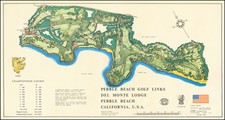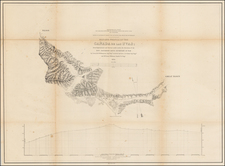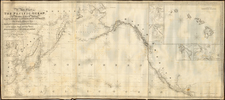LA Letters Archive
A remarkable group of 25 original manuscript letters by members of the Temple and Workman families - pioneers of the Pueblo de Los Angeles - who bridged the Mexican and American eras of California history. Includes an extraordinarily early letter from 1832 by patriarch Jonathan Temple to fellow English-speaking Californio John B. R. Cooper of Monterey, also letters addressed to William Workman, and many letters penned by Workman's son-in-law, Francis Pliny Fisk Temple, who was Jonathan's younger brother. Other correspondence is by and between family members and business associates. The earliest letters date from the Mexican era, mostly from the 1840s, encompassing the Mexican War and California's transition to American control, with the remainder dating mainly from the 1850s and 1870s.
Notable topics in the letters: the Mexican War in California, with a mention of Col. Stevenson's Regiment of New York Volunteers and the departure of the Mormon Battalion for Salt Lake; John C. Frémont's purchase of Alcatraz Island from Francis P. F. Temple; two letters relating to early wine production in Los Angeles; an extensive list of items to import into California in 1847, for the benefit of an East Coast sibling with "California Fever"; gold shipments from Los Angeles mines mentioned in an 1845 letter - years before the opening salvo of the California Gold Rush; general reporting about Los Angeles's growth and prospects; and details on the collapse of the family's banking business.
These letters stand as important, content-rich primary sources for early Los Angeles, especially for covering the transition of Mexican Los Angeles to the American era, and for documenting the rise and fall of a powerful Southern California family that embodied the region's multi-cultural roots.
The Temple and Workman Families
The Temple and Workman families played a significant role in mid to late 19th-century Los Angeles and by extension influenced the early development of Southern California as a whole. Key members of the family, including Jonathan Temple, William Workman and Francis Pliny Fisk Temple were major players in early Los Angeles real estate, banking and agriculture. The early successes of this American family in Mexican California was aided by familial and social connections with Spanish-speaking Californios such as Pio Pico, who is buried in the El Campo Santo Cemetery located within the Temple-Workman homestead compound in present day City of Industry.
Jonathan Temple (1796-1866), the first person from either of the two families to settle in Southern California, often used his Californio moniker Don Juan Temple. A native of Reading, Massachusetts, he lived in San Diego briefly before establishing an American-style store in Los Angeles in 1828. In 1843, he acquired the Rancho Los Cerritos, a 27,000-acre property in the Long Beach area - his 1844 adobe is the centerpiece of the Rancho Los Cerritos historic site. Temple was one of the first real estate developers in L.A., having constructed the original Temple Block and the Market House, which later served as city and county administrative headquarters and the seat of the county courthouse. He took on a leadership role in Los Angeles when the town was captured by the United States during the Mexican War.
Francis Pliny Fisk Temple, Jonathan's younger half brother, was another prominent figure in the early development of Southern California. The younger Temple married the daughter of William William, an English-born pioneer who arrived in Los Angeles from Santa Fe via the Old Spanish Trail route in 1841, as part of the Workman-Rowland Party - considered the first overland party of Americans to settle in Los Angeles. Through hard work and business acumen, Workman became one of the city's most successful entrepreneurs. He co-owned a store, served as a judge, and invested in real estate. Francis Pliny Fisk Temple expanded the family business into banking, and also became one of the largest landowners in the region.
The 25 letters cover the gamut of the Temple and Workman family interests: land, trade, winemaking, the Mexican War, local politics, and personal family matters.
Outstanding letters from the group are described below. Detailed descriptions, including translations of the Spanish language letters, available upon request.
- Jonathan Temple to fellow English-speaking Californio John B. R. Cooper. Los Angeles. Jan. 2, 1832. 1 page.
An extremely early letter written from the Pueblo de Los Angeles by noted American businessman turned Californio, Jonathan Temple, to English-born Californio John B. R. Cooper of Monterey. The letter includes a tantalizing reference to Juan Bautista Alvarado (future governor of Alta California) and "these times of revolution." Just one day before this letter was written Pio Pico had taken over the government after a brief coup that removed Governor Manuel Victoria. This revolt has been styled the first Californio revolt against the Mexican-appointed California government.
- Francis P. F. Temple to his sister Cynthia, contemporary retained copy. Los Angeles. Jan. 29, 1843. 1 page.
A remarkable artifact - an 1843 manuscript letter written from Pueblo de Los Angeles. In this neatly-penned contemporary retained copy, Francis Pliny Fisk Temple writes to his sister from "Pueblo de los Angeles," complaining about the dearth of reading material: California being so remote section of the world it is impossible to have any thing in the way of recent news.
- Abraham Temple to his brother Francis Pliny Fisk Temple. Reading, Mass. Oct. 24, 1845.
An East Coast brother relates that he "has a slight touch of the California Fever," while acknowledging receipt of gold sent from Los Angeles:
The
GLand [i.e. Gold] you sent was of good quality. I have disposed of it at 18$ per oz their [sic] is a difference in the weights of the countries yours being lighter than ours, but I think you may do well to send on more if you can obtain it at $14 per oz.
While the above passage is somewhat cryptic, the context, price per ounce and crossed-out "G" make it all but obvious that Abraham Temple is referring to gold. The Los Angeles ore must have come from the gold discovery made by Francisco López, a compadre of William Workman, in Placerita Canyon on March 9, 1842.
- Francis P. F. Temple to his brother Abraham Temple, including a general description of California resources, business opportunities, goods to bring, prices for lumber, and the like. Los Angeles. June 28, 1847. 4 pages.
A lengthy and richly detailed early letter from Pueblo de Los Angles. Francis P. F. Temple prescribes "the only remedy" for his brother's case of the California Fever "is to take a trip out here." Temple gives a brief overview of the current situation in Southern California:
I regret that you did not come out ten years ago, when the country was in a flourishing condition, at that time the missions were in their bloom the country covered with immense herds of cattle, money plenty & a few people to do the business, but now it is quite the reverse, the missions are nearly broken down, a very few cattle in comparison with those times, money scarce, and a greater number of people to do the business, even the climate has greatly changed, however it is still a beautiful climate, the most disagreeable time is in the rainy season which is from Nov. to March, more or less after the rains the country looks beautiful for two or three months, and then the vegetation drys up & remains so until the rains of the following season on this account a greater part of the country is unfit for cultivation - those parts which can be irrigated by small rivers & streams are the only parts which can be cultivated.
The letter also includes a detailed list of goods for a Yankee trader to bring to California:
...blue cotton, blue drilling, bleach'd & unbleached cotton, cassimere broadcloths, muslins, ribbons, boots & shoes, gilt shirt & pantaloon buttons, spool & hank thread, mens & wos. cotton & wosted stockings, two or three medicine chests, percussion caps, cotton & silk hdkfs, cuttery, manufactured & leaf tobaccos, looking glasses, framed pictures & saints, calicos, furniture prints, bedticking, counterframes, shovels, hoes, axes, hatchets, pantaloon & coat stuffs, silk velvet, readymade clothing both woolen & cotton, mens slippers, fancy gown patterns, toys & confectionary would also take well, & lots of other fancy articles which cost but very little there, & would pay a good profit here.
- Francis P. F. Temple, a pair of letters to his brother Abraham Temple, mentioning his sale of Alcatraz Island to John C. Frémont; and other Los Angeles news. 2 letters. Los Angeles. April 22 and May 2, 1848. Total of 2 1/2 pages.
A fascinating pair of letters relating to the sale of Alcatraz Island to John C. Frémont. Temple writes to his brother in Massachusetts, Abraham Temple, with general news from Los Angeles, and, amazingly, a reference to his pending sale of Alcatraz to Frémont, the latter then serving as acting military governor of California.
The first letter mentions the Alcatraz transaction, specifically that he, Temple, had endorsed the $5000 bond from Frémont in favor of Captain William Dane Phelps, who would attempt to collect on the bond in Washington. The bond was apparently never paid due to Frémont's court-martial, which invalidated many of his official actions while military governor. In 1850 President Millard Fillmore declared Alcatraz a military possession. Members of the Temple family continued to pursue a claim on Alcatraz well into the 20th century, but no serious foundation for their claim ever developed. The letter also includes Mexican War-related news in California:
The country remains quiet, Col. Stevenson with a part of the 1st Regt. of N.Y. volunteers are stationed here, also one company of Dragoons - the Mormons have left for Salt Lake they have quite a settlement at that place it is about eight hundred miles distant.
The second letter, dated May 2, 1848, also by Francis P. F. Temple to his brother Abraham, adds further details on the Frémont bond stemming from the sale of Alcatraz and includes an interesting reference to a Mr. Mellus - almost certainly Henry Mellus, the future mayor of Los Angeles.
- Gregorio de Ajuria to William Workman, aka Don Julian Workman, relating to Juan Matias Sanchez and gambling. Los Angeles. September 2, 1853. 1 page in Spanish.
Intriguing letter addressed to William Workman, the English-born patriarch of the Temple-Workman clan, from a prominent Spanish-born businessman who was connected by marriage to the Temple and Workman families. The letter was delivered by "El Inio Alon" who carried it on horseback from downtown Los Angeles to Rancho La Puente. It concerns an incident that illustrates the close-knit social ties of compadrismo that survived among Californios into the American era. The Spanish-born Ajuria, a recent arrival who had married Jonathan Temple's daughter, here complains how a compadre of Workman's, Juan Matias Sanchez, had apparently lost 11,000 pesos during a serious gambling spree. Sanchez was Workman's trusted mayordomo, indeed the two men had known each since their New Mexico days going back to the 1830s. The gambling incident likely only further strengthened the ties of loyalty between Workman and Sanchez. Nearly twenty-five years after this letter Sanchez would put up his personal rancho landholdings in a desperate effort to help his old friend William Workman (and thus the extended Temple and Workman clan) avert financial ruin. The effort failed and William Workman took his own life due to the financial catastrophe which was precipitated by the failure of the Temple & Workman Bank. In retrospect this letter serves as a poignant example of the deep social connections of Californio society.
- Letter to William Workman from French-born Californio winemaker Antonio Labory, aka Antoine Laborie, about wine pipas or casks and buying grapes in Los Angeles. Los Angeles. Oct. 7, 1857. 1 page in Spanish.
This hastily written letter, penned in Spanish and delivered by horse-mounted courier, was written by French-born Californio winemaker Antoine Labory to William Workman. The letter concerns the latter's order for 16 large wine casks or pipas. Each of these large barrels or casks likely held over 100 gallons of wine.
This letter stands as evidence of the fascinating cross-cultural milieu of early Los Angeles, as the two correspondents, a French-born winemaker, and the English-born pioneer known as "Don Julian," had both transformed themselves into Spanish-speaking Californios.
Antoine Labory, born Antoine Labrorie on April 21, 1819 in Arbis, France, arrived in Los Angeles in 1844 with a group of artisans and aspiring winemakers from Gironde-Bordeaux that included Pierre-Esliens Vignes (a relative of pioneer Los Angeles winemaker Jean-Louis Vignes - AKA Don Luis del Aliso, the father of California winemaking). By the 1860s Labory's name appears on numerous real estate documents, including one indicating his ownership of a vineyard property near the Los Angeles River.
Winemaking has a long history in Los Angeles, with the first vineyards planted by Spanish missionaries in the 18th century. According to some accounts, Los Angeles boasted over 100 vineyards in 1850.
- Francis P. F. Temple to his son John Temple, describing the grape harvest and wine production in Los Angeles, recent rapid growth of the town, increase in land prices, and the like. Los Angeles. Dec. 6, 1874. 3 pages.
The letter describes the rapid growth and development of Los Angeles, progress in agricultural crops, and contains an early mention of winemaking in Los Angeles. Temple reports that the supply of pipes to store the wine is insufficient. He makes reference to Francis, another son, being an avid student of wine production who will soon "understand the business as well as Mr. Lambourne." The younger Francis had recently returned to Los Angeles after a year or so of study at M.I.T. and was supervising the wine operation on the Workman ranch. Frederick Lambourn was Workman's English-born ranch foreman who also worked as a private tutor for the family. The letter also reports that grandfather (i.e. William "Don Julian" Workman (1799-1876), the patriarch of the Temple-Workman clan) had made over 100 pipes of wine in the present season. In little over a year William Workman would commit suicide by a pistol shot to the head, destitute over the fallout of the family's financial difficulties.
-
The remaining 16 letters add further detail to the overall record of extensive family and business networks connecting the Los Angeles-based Temple and Workman families with East Coast relatives and associates. One curious letter from Francis W. Temple to his father Francis P. F. Temple, dated Aug. 7, 1872 from Reading, Massachusetts, describes the process by which the younger Temple had his cranium measured by the famous phrenologist, O. S. Fowler. Several letters from this group record the declining fortunes of the family's business empire, caused by the failure of the Temple & Workman Bank in 1876. A tragic effect of the financial collapse is recorded in the last letter, dated May 22, 1876, wherein Francis P. F. Temple reports to his son that William Workman had commited suicide over the financial problems - a poignant capstone to the collection:
Dear John, It is with sorrow that I have to inform you that your grandfather took his life on the evening of the 17th about 6 o'clock, and was buried on the afternoon of the 19th at 1 o'clock by the Masons. Our financial troubles caused him to do this rash act...Your affte. father, F. P. F. Temple.









![(Stockton, California) [Manuscript Railroad Map of Stockton, California, on three sheets; Mormon Channel (Slough), Stockton Electric Railway; heavily annotated]](https://storage.googleapis.com/raremaps/img/small/96266.jpg)


![[ Oregon / Northern California Coast ] A Chart Shewing Part of the Coast of N.W. America, with the Tracks of His Majesty's Sloop Discovery and Armed Tender Chatham . . .](https://storage.googleapis.com/raremaps/img/small/102069.jpg)

![Lands of the Hemet Land Co. [Hemet Southern California. Its homes and scenes]](https://storage.googleapis.com/raremaps/img/small/89106.jpg)